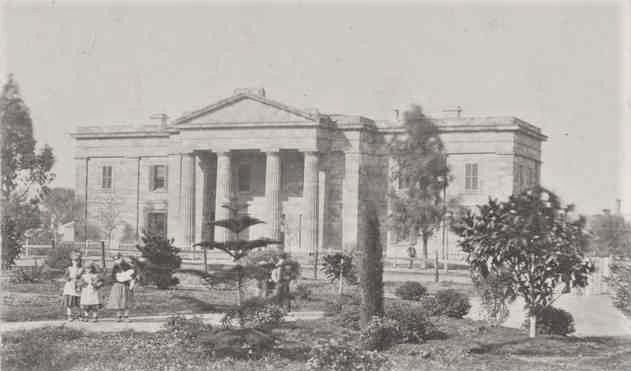Sandstone starts as sand from erosion depositing in oceans, rivers, creeks and lakes. But it's still just sand. Later when this sand is buried, and secondary minerals are also deposited, these secondary minerals cement the sand together, turning sand into sandstone. Cementing compounds consist of a number of minerals, including iron and manganese compounds, calcite and silicates. Cementing minerals can precipitate out of solution. Fronts of cementing mineral solutions moving through the sand/sandstone may be precipitated unevenly, leaving behind bands of discoloration that are not related to the original sand depositional features, but due to the preciptitaion of secondary minerals.
The building in front of you opened as the Supreme Court of South Australia in 1851. From 1873 it was the Local and Insolvency Courts. After 1891 the building became the Police Courts for the next hundred years. In 1997 the building became the Magistrates Courts. The building features a distinctive façade of golden sandstone with a doric portico. The court is one of the oldest public buildings in Adelaide. Construction began in 1847. There were difficulties and delays with the erection of the building, particularly in obtaining a sufficient number of large blocks of suitable stone at an early time in the state's history. It is reported that the sandstone blocks was sourced from several quarries, including Beaumont, Mitcham, Finniss River and Stirling.
At this unique sandstone building you can see fine bands of various colours different from the pale matrix rock in the stone blocks. These darker bands, and in some cases rings, are mineral deposits of higher concentrations cementing the sandstone. These bands of discoloration of cementing minerals are what you see here, and in sandstone the bands are referred to as Liesegang Bands after German chemist Raphael E. Liesegang who noted the preciptitaion phenomenon.
Liesegang bands are features caused during the formation of sedimentary rocks by a precipitation of chemical compounds. Often gaps, fissures and cracks act as conduits and passages for the mineral solutions. The rock is saturated with regard to chemical compounds, which get between deposition layers and succeed in cementing them together in regular concentric shapes. The bands may be different in the chemical composition, known a segregation, and show gradual change by colour. Sometimes Liesegang bands form around a nucleus, or centre-point from where the bands continue to form outwards in regular ring patterns. Alternatively the structures form concentrically inwards, roughly parallel to the rock surface, but may follow profiles of defects and fissures.
Visit the listed coordinates of this Earthcache, examine the building façade, and please answer the following questions. You may log your find immediately. Do not forget to send your answers by email or message.
1. At the bottom of the right-side blank door portal are two examples of bands formed from a fissure. What is the orientation of these fissures?
2. What is the band shape that can be seen in the block directly under the National Trust disk? Is this shape common?
3. Some ring-like patterns, e.g. tree rings, are caused by seasonal variations in temperature or rainfall. Are Liesegang bands in sandstone rocks due to seasonal variations?
4. Post a photo of your visit. Use the image on the cache page from 1860 as a guide.
